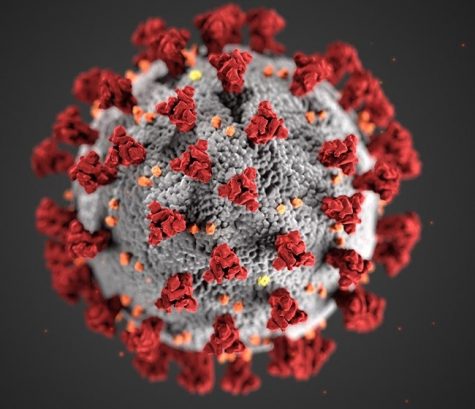COVID-19: The Science Behind the Virus
March 20, 2020
With not much else to do during this extended spring break, gossip and rumors about the Coronavirus have spread like the pandemic itself. In the midst of so much information, it’s hard to figure out what’s real and what’s been distorted like a game of telephone. To keep you from going batty while sorting through it all, here’s the facts and science behind COVID-19: what it is, where it came from, why it’s spreading so fast, and what to do.

A close-up of COVID-19–notice the spikes surrounding the main body. These allow the virus to grab on to our cells so easily, and also give coronaviruses their name.
What it is
The coronavirus affecting us today isn’t the only one of its kind. According to the CDC, coronaviruses are named for the crown-like spikes on their surfaces, “corona-” meaning “crown” in Latin. The official name for the virus that’s quarantining us today is coronavirus disease 2019, or COVID-19 for short.
“Coronaviruses are a large family of viruses,” says the CDC. “Some cause illness in people, and others, such as canine and feline coronaviruses, only infect animals.” Rarely, a coronavirus can spread from animals to humans. This happened in 2003 and 2012, causing Severe Acute Respiratory Syndrome (SARS) and Middle East Respiratory Syndrome (MERS), respectively.
Where it Came From
This animal-to-human spread is likely the source of COVID-19, but not from “bat soup,” as many people are saying. In fact, according to Korin Miller from health.com, the viral video and photos of a Chinese woman eating bat soup
were from 2016, on an island in the Pacific Ocean known as Palau. The woman in the video has been identified as Wang Mengyun, the host of an online travel show. She recently apologized for the video to the South China Morning Post.

An image from the viral video that spread the “bat soup” rumor.
Though bat soup isn’t the culprit behind COVID-19, bats may not be entirely blameless. According to scientists from the Journal of Medical Virology, the pandemic likely originated at a wet market (a market selling meat, produce, and other perishable goods) in China. The proteins and genetic coding of COVID-19 did match those in bats—but also snakes. Snakes often hunt bats in the wild, so a snake sold at a market in Wuhan could have carried the disease from bat to human.
Why It’s Spreading So Fast
Now that we’ve busted some myths surrounding the origin of COVID-19, why has it become such a pandemic? There are a few major factors contributing to the outbreak, one of which simply being natural selection. This particular coronavirus has an extremely effective receptor-binding domain (RBD), a kind of grappling hook that grips on to host cells. According to sciencedaily.com, scientists from the Scripps Research Institute found that “the RBD portion [of COVID-19]… had evolved to effectively target a molecular feature on the outside of human cells called ACE2, a receptor involved in regulating blood pressure.” All coronaviruses work in a similar way—COVID-19 just does its job better than the rest.
Another factor contributing to the pandemic is the “waiting period” of COVID-19. The CDC believes that symptoms of this coronavirus can take as long as fourteen days to appear. This means that someone who’s been infected can pass the disease to others for two weeks before even realizing that they’re infected. With the amount of people we all encounter in two normal weeks, it’s no wonder that self-quarantine is so strongly suggested.
What to do
To keep yourself safe from COVID-19, wash your hands regularly, cover your coughs and sneezes with a tissue, disinfect surfaces you touch regularly, and stay home as much as possible for these next few weeks.










